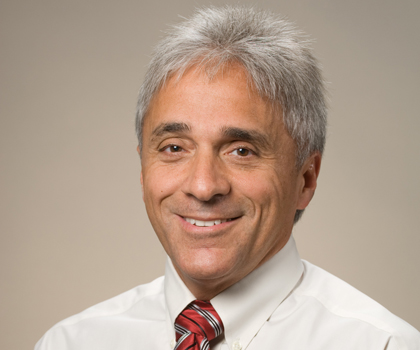March is Colorectal Cancer Awareness Month. Among cancers that affect both men and women, colorectal cancer is the second leading cause of cancer-related deaths in the U.S., but it is also one of only a few cancers that may be prevented through screening.

James Vecchio, M.D., professor of medicine at the Larner College of Medicine and medical director of gastroenterology and hepatology at the UVM Medical Center (Photo: LCOM Creative Services)
March is Colorectal Cancer Awareness Month. Among cancers that affect both men and women, colorectal cancer is the second leading cause of cancer-related deaths in the U.S., but it is also one of only a few cancers that may be prevented through screening. James Vecchio, M.D., professor of medicine and medical director of gastroenterology and hepatology at the University of Vermont Medical Center, provided the information, below, in a blog post, titled “What Should I Expect When Undergoing a Colonoscopy,” for the UVM Medical Center blog.
Q: What should I expect when undergoing a colonoscopy?
A: The most important part of a colonoscopy is the prior colon cleansing preparation. It is important to very carefully follow the instructions from your physician’s office regarding this cleansing preparation.
- Arrive at least an hour prior to the scheduled procedure time.
- Remove any jewelry and leave it at home.
- Make arrangements with a family member or a friend to help get you home after the procedure. It is important to understand you will be sedated during the colonoscopy. Therefore, you will not be able to drive a vehicle after the procedure has been performed.
Once you arrive at the endoscopy suite, a nurse and other hospital staff member will obtain pertinent medical information prior to the procedure. You will then be escorted to a private curtained area where you will be placed in a hospital gown.
A small intravenous catheter will be inserted into a vein in your arm or hand. You will be then be transported on a stretcher to the endoscopy room. In the endoscopy room an endoscopy nurse, an endoscopy technician and the endoscopist who is to perform the procedure will greet you. The endoscopy room will have a series of equipment including flat monitor television screens and adjustable lighting. The procedure will be explained to you once again in detail prior to your signing a consent form.
Monitoring equipment will be set up, such as a blood pressure cuff and a pulse oximeter (a clothes pin-like device attached to a finger; this device will make a beeping noise as it measures your heart rate and level of breathing).
Next, the nurse will gently place plastic nasal prongs in your nostrils to provide a steady flow of oxygen during the procedure. The endoscopy nurse will then slowly administer sedation medications through the previously inserted intravenous catheter. Sometimes a warm or slightly burning feeling is felt in the vein in your arm as the sedation is administered. The sedation medications work very quickly and induce a state of conscious sedation (a drowsy, relaxed feeling) and many times sleep is induced.
The procedure is then performed. After the colonoscopy is completed, you are wheeled out on the stretcher to the recovery area. In the recovery area, the recovery area nurses will monitor you until the nurses feel you have adequately recovered from the sedation from the procedure to go home. Written information and instructions regarding the findings of the colonoscopy will be presented to you prior to your departure from the recovery unit.
Learn more about colorectal cancer diagnosis and treatment at the University of Vermont Medical Center. Visit the National Colorectal Cancer Roundtable website for more information.